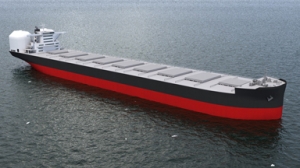


(Posted on 31/01/19)
Leading Classification Society ClassNK has granted an Approval in Principle (AIP) based on its Rule Part GF which adopts IGF Code (regulation for ships using low-flashpoint fuels) to Kawasaki Heavy Industries (KHI) for their project on the concept design of an LNG-fuelled 207K DWT bulk carrier.
Speaking on the occasion, ClassNK Corporate Officer and Director of Technical Solution Department Hayato Suga said “The maritime industry has been setting its sights on LNG as an energy source for ships as it is an environmentally-friendly alternative to fossil fuels. Kawasaki Heavy Industries is taking full advantage of this opportunity as well with their new bulk carrier design. We have carefully confirmed the safety of the design and are proud to contribute to this project.”
With the International Maritime Organization (IMO) imposing tighter restrictions on emissions of greenhouse gases and air pollutants, the shipping industry has been increasing its focus on utilizing LNG and other “clean” fuels in place of conventional fuel oil. Against this backdrop, and utilizing technological prowess attained through building LNG carriers for many years, Kawasaki has been developing various LNG-related vessels, such as the world’s first LNG-fueled car carrier, delivered in 2016, and LNG bunkering vessels, which has culminated in an ample pool of LNG-related application technology. Combined with additional technological innovations and knowledge developed in the course of acquiring the AiP for this bulk carrier, which complies with the latest international regulations, Kawasaki is fully equipped to proceed with its design and building, as well as to apply these technologies to other types of ships.
Moving forward, Kawasaki plans to widen its application of LNG propulsion technology in commercial vessels, and to increase its focus on building LNG-fueled vessels, for which demand is expected to grow globally in the future.
Principal features of the new LNG-fueled carrier
1)By configuring the LNG fuel tank behind the accommodation in the stern, the ship keeps its cargo space as large as that of conventional oil-fueled ships.
2)Powered by low-speed, dual-fuel diesel engine, the ship achieves significantly reduced emissions of carbon dioxide (CO2), nitrogen oxides (NOx), sulfur oxides (SOx), and particulate matter (PM) when using LNG as fuel, meeting the EEDI**Phase 3 requirements.
Helm Operations has announced that nine electronic record books within Helm CONNECT Logbook have been... Read more
International maritime welfare charity Sailors’ Society has announced a significant expansion... Read more
NORDEN has signed a two-year Contract of Affreightment (COA) with Enviva to transport a significant... Read more
Algoma Central Corporation has reported its results for the three and nine months ended 30 September... Read more
Damen Shipyards Group has unveiled the latest platform in its successful cargo vessels portfolio. The... Read more
Wallem Group, a leading global maritime partner, is celebrating the centenary of moving its headquarters... Read more
The International Association of Dry Cargo Shipowners (INTERCARGO) is marking its 45th anniversary in... Read more
Net profit for the Group amounted to USD 26 million (DKK 166 million) in the third quarter of 2025,... Read more
ClassNK has released 'Guidelines for Onboard CO2 Capture and Storage Systems (Edition 2.0)' first in... Read more
Following the International Maritime Organisation’s (IMO’s) newly tightened rules on enclosed... Read more